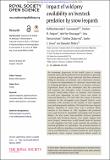Files in this item
Impact of wild prey availability on livestock predation by snow leopards
Item metadata
| dc.contributor.author | Suryawanshi, Kulbhushansingh R. | |
| dc.contributor.author | Redpath, Stephen M. | |
| dc.contributor.author | Bhatnagar, Yash Veer | |
| dc.contributor.author | Ramakrishnan, Uma | |
| dc.contributor.author | Chaturvedi, Vaibhav | |
| dc.contributor.author | Smout, Sophie C. | |
| dc.contributor.author | Mishra, Charudutt | |
| dc.date.accessioned | 2017-06-26T14:30:10Z | |
| dc.date.available | 2017-06-26T14:30:10Z | |
| dc.date.issued | 2017-06-07 | |
| dc.identifier | 250335721 | |
| dc.identifier | 817d0b9d-bb11-4c1a-989e-0da38834ff67 | |
| dc.identifier | 85020425086 | |
| dc.identifier | 000404843200013 | |
| dc.identifier.citation | Suryawanshi , K R , Redpath , S M , Bhatnagar , Y V , Ramakrishnan , U , Chaturvedi , V , Smout , S C & Mishra , C 2017 , ' Impact of wild prey availability on livestock predation by snow leopards ' , Royal Society Open Science , vol. 4 , 170026 . https://doi.org/10.1098/rsos.170026 | en |
| dc.identifier.issn | 2054-5703 | |
| dc.identifier.uri | https://hdl.handle.net/10023/11089 | |
| dc.description | The fieldwork was supported by Fondation Segré-Whitley Fund for Nature, Conservation Leadership Programme and National Geographic Young Explorer fund. These grants supported K.R.S., Y.V.B. and C.M. Laboratory analysis was supported by the Department of Science and Technology, Government of India. This grant supported U.R., V.C., Y.V.B., K.R.S. and C.M. Data Dryad Repository. (http://dx.doi.org/10.5061/dryad.8p689) | en |
| dc.description.abstract | An increasing proportion of the world’s poor is rearing livestock today, and the global livestock population is growing. Livestock predation by large carnivores and their retaliatory killing is becoming an economic and conservation concern. A common recommendation for carnivore conservation and for reducing predation on livestock is to increase wild prey populations based on the assumption that the carnivores will consume this alternative food. Livestock predation, however, could either reduce or intensify with increases in wild prey depending on prey choice and trends in carnivore abundance. We show that the extent of livestock predation by the endangered snow leopard Panthera uncia intensifies with increases in the density of wild ungulate prey, and subsequently stabilizes. We found that snow leopard density, estimated at seven sites, was a positive linear function of the density of wild ungulates—the preferred prey—and showed no discernible relationship with livestock density. We also found that modelled livestock predation increased with livestock density. Our results suggest that snow leopard conservation would benefit from an increase in wild ungulates, but that would intensify the problem of livestock predation for pastoralists. The potential benefits of increased wild prey abundance in reducing livestock predation can be overwhelmed by a resultant increase in snow leopard populations. Snow leopard conservation efforts aimed at facilitating increases in wild prey must be accompanied by greater assistance for better livestock protection and offsetting the economic damage caused by carnivores. | |
| dc.format.extent | 11 | |
| dc.format.extent | 581803 | |
| dc.language.iso | eng | |
| dc.relation.ispartof | Royal Society Open Science | en |
| dc.subject | Apparent competition | en |
| dc.subject | Apparent facilitation | en |
| dc.subject | Conservation conflicts | en |
| dc.subject | Indirect interactions | en |
| dc.subject | Predator | en |
| dc.subject | Prey interactions | en |
| dc.subject | Snow leopard | en |
| dc.subject | QH301 Biology | en |
| dc.subject | General | en |
| dc.subject | DAS | en |
| dc.subject.lcc | QH301 | en |
| dc.title | Impact of wild prey availability on livestock predation by snow leopards | en |
| dc.type | Journal article | en |
| dc.contributor.institution | University of St Andrews. School of Biology | en |
| dc.contributor.institution | University of St Andrews. Sea Mammal Research Unit | en |
| dc.contributor.institution | University of St Andrews. Scottish Oceans Institute | en |
| dc.contributor.institution | University of St Andrews. Centre for Research into Ecological & Environmental Modelling | en |
| dc.identifier.doi | https://doi.org/10.1098/rsos.170026 | |
| dc.description.status | Peer reviewed | en |
This item appears in the following Collection(s)
Items in the St Andrews Research Repository are protected by copyright, with all rights reserved, unless otherwise indicated.

